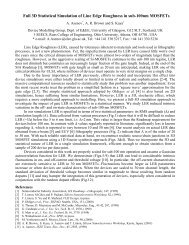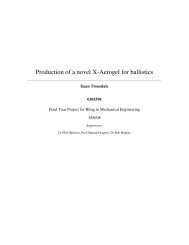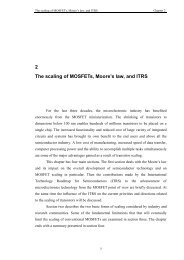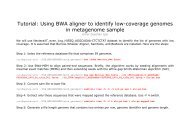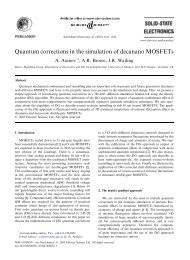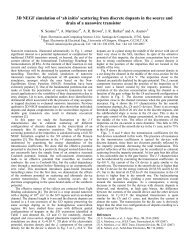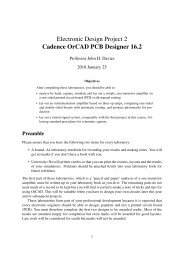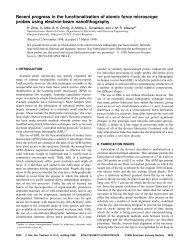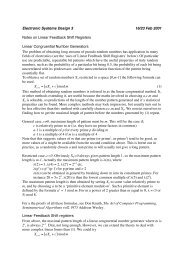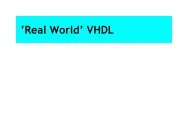72P. GRASSL AND M. JIRÁSEKincorporated, which allows mesh-independent description of energy dissipation in a <strong>local</strong>izedfailure process. Typically, the deformations remain continuous even in the <strong>local</strong>ized zone. Forintegral-type <strong>non</strong>-<strong>local</strong> <strong>model</strong>s, the interaction between neighbouring points is taken in<strong>to</strong>account by weighted spatial averaging. Such formulations were initially proposed in the contex<strong>to</strong>f elasticity [1] and hardening plasticity [2], and they were <strong>applied</strong> as <strong>local</strong>ization limiters for thefirst time by Pijaudier-Cabot and Bazˇ ant [3] in the context of <strong>damage</strong> mechanics. For softeningplasticity, integral-type <strong>non</strong>-<strong>local</strong> <strong>model</strong>s were developed, for instance, by Bazˇ ant and Lin [4],Vermeer and Brinkgreve [5], Leblond et al. [6], Tvergaard and Needleman [7], or Stro¨mberg andRistinmaa [8]. Thermodynamic aspects were discussed by Svedberg and Runesson [9] andBorino et al. [10], and numerical implementation issues by Benvenuti and Tralli [11] andRolshoven and Jira´sek [12]. For an overview and discussion of various <strong>non</strong>-<strong>local</strong> plasticityformats, see Reference [13].With plasticity or <strong>damage</strong> mechanics alone, the complex failure process of cohesive-frictionalmaterials, which is characterized by stiffness degradation and irreversible deformations, cannotbe <strong>model</strong>led satisfac<strong>to</strong>rily. <strong>Plastic</strong>ity is based on an elastic unloading stiffness, which is incontradiction <strong>to</strong> the stiffness degradation observed in experiments. Damage mechanics, on theother hand, is not suitable for the description of the irreversible deformations. A combination ofplasticity and <strong>damage</strong> mechanics can describe most of the important features of the failure ofcohesive-frictional materials. Combinations of stress-based plasticity and scalar <strong>damage</strong> weredeveloped, for example, by Ju [14], Lubliner et al. [15], Lee and Fenves [16], Gatuingt andPijaudier-Cabot [17], Bourgeois et al. [18], Kra¨tzig and Polling [19], Jason et al. [20, 21], Salariet al. [22], and Grassl and Jira´sek [23, 24]. Regularization of such <strong>model</strong>s by gradient <strong>damage</strong>formulations was proposed by de Borst et al. [25] and Addessi et al. [26].A special group of integral-type <strong>non</strong>-<strong>local</strong> <strong>damage</strong>-plastic <strong>model</strong>s, for which the <strong>damage</strong> partis driven by a <strong>non</strong>-<strong>local</strong> measure of the plastic strains, was studied analytically by Jira´sek andGrassl [27]. The present paper is a continuation of that work. The conclusions of the analyticalstudy of the <strong>non</strong>-<strong>local</strong> <strong>damage</strong>-plastic <strong>model</strong> are confirmed by one- and two-dimensionalexamples using simple versions of such <strong>model</strong>, in two dimensions <strong>with</strong> <strong>non</strong>-associated flow. Inparticular, the conditions for a mesh-independent description of the zone of inelastic strains arestudied. Then, the framework is <strong>applied</strong> <strong>to</strong> an advanced <strong>damage</strong>-plastic <strong>model</strong> for <strong>concrete</strong>,recently developed by the present authors [23, 24]. With this <strong>non</strong>-<strong>local</strong> <strong>damage</strong>-plastic <strong>model</strong>,structural examples of tensile and compressive failure are computed.2. BASIC EQUATIONS OF COMBINED PLASTICITY AND DAMAGEIn the present section, the framework for the combination of stress-based plasticity and strainbasedscalar <strong>damage</strong> is first presented in the <strong>local</strong> setting. The general stress–strain relation forthis class of <strong>model</strong>s isr ¼ð1 oÞD e : ðe e p Þ¼ð1 oÞ%r ð1Þwhere r is the stress, o is the <strong>damage</strong> variable, D e is the isotropic elastic stiffness, e is the strain,e p is the plastic strain, and %r ¼ D e : ðe e p Þ is the effective stress. For o ¼ 0; Equation (1)reduces <strong>to</strong> the stress–strain relation of an elastic–plastic <strong>model</strong>, and for e p ¼ 0 <strong>to</strong> an elastic<strong>damage</strong><strong>model</strong>. Of course, the stress–strain equation (1) must be supplemented by certain lawsspecifying the evolution of plastic strain and <strong>damage</strong>. In paper [24], the present authors compareCopyright # 2005 John Wiley & Sons, Ltd. Int. J. Numer. Anal. Meth. Geomech. 2006; 30:71–90
PLASTIC MODEL WITH NON-LOCAL DAMAGE 73several options and propose an approach using a yield condition postulated in the effectivestress space and a <strong>damage</strong> law driven by the plastic strain.The plastic part of the <strong>model</strong> is based on the standard flow theory of plasticity, <strong>with</strong> all thebasic equations written in terms of the effective stress:’e p ¼ l ’ @g pð%r; k p Þð2Þ@%r’k p ¼ ’lk p ð%r; k p Þ ð3Þs y ¼ hðk p Þð4Þf p ð%r; s y Þ40; l50; ’ lfp ’ ð%r; s y Þ¼0 ð5ÞHere, a superimposed dot denotes the time derivative, l is the plastic multiplier, k p is theplastic hardening variable, g p is the plastic potential, k p is a scaling fac<strong>to</strong>r that relates the rateof the plastic multiplier <strong>to</strong> the rate of the hardening variable (this fac<strong>to</strong>r is often constantbut, in general, can depend on the current values of stress and hardening variable), s y isthe current yield stress, h is the hardening function, and f p is the yield function. No softeningis considered in the plastic <strong>model</strong> itself, i.e. the hardening function h is <strong>non</strong>-decreasing.Softening effects are attributed <strong>to</strong> cracking and taken in<strong>to</strong> account by the <strong>damage</strong> part of the<strong>model</strong>.The <strong>damage</strong> evolution is driven by a certain internal variable k d ; which typically remains zeroduring the initial stage of plastic hardening and starts growing when the yielding process attainsa critical level. The corresponding value of k p is denoted as k 0 : The subsequent evolution of k d isclosely linked <strong>to</strong> the plastic strain rate. For simple versions of the <strong>model</strong>, we set ’k d ¼ ’k p ; so thatk d can be identified <strong>with</strong> the difference k p k 0 : For the <strong>model</strong> that aims at realistic descriptionof <strong>concrete</strong> (<strong>to</strong> be presented in Section 6), ’k d is related <strong>to</strong> the plastic strain rate through a morecomplicated expression; see Equation (19). The <strong>damage</strong> variable o is a function of the internalvariable k d ; i.e.o ¼ g d ðk d Þð6Þwhere the <strong>damage</strong> function g d mono<strong>to</strong>nically grows from zero <strong>to</strong> one.The algorithm for the stress update of this type of <strong>model</strong>s is divided in<strong>to</strong> two stages. First,the update of the effective stress for the plastic part is carried out by an implicit algorithm; then,the <strong>damage</strong> part is evaluated explicitly from the plastic strain increment obtained in thefirst stage.3. REGULARIZATION BY NON-LOCAL DAMAGEThe pathological mesh sensitivity of results obtained <strong>with</strong> <strong>local</strong> constitutive laws thatincorporate strain softening can be overcome by a suitable regularization technique, whichenforces mesh-independent dissipation associated <strong>with</strong> the failure process. Integral-type <strong>non</strong><strong>local</strong><strong>model</strong>s achieve this by weighted spatial averaging of a suitable state variable. Damage<strong>model</strong>s of this kind were first proposed by Pijaudier-Cabot and Bazˇ ant [3, 28], but many otherformulations appeared in the literature; see Reference [29] for a systematic comparison. OneCopyright # 2005 John Wiley & Sons, Ltd. Int. J. Numer. Anal. Meth. Geomech. 2006; 30:71–90



